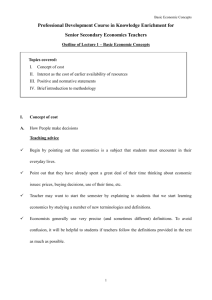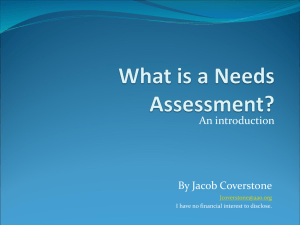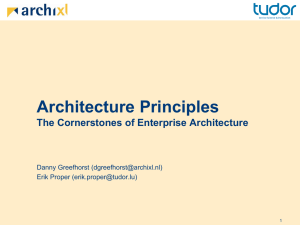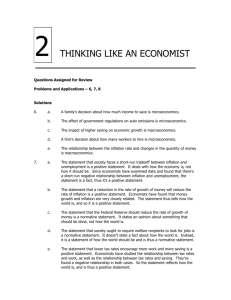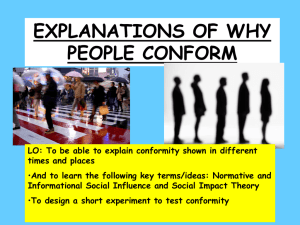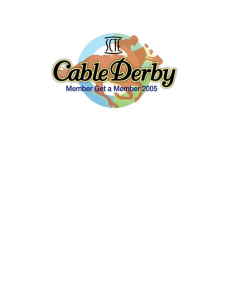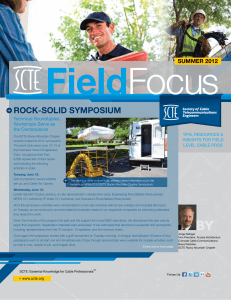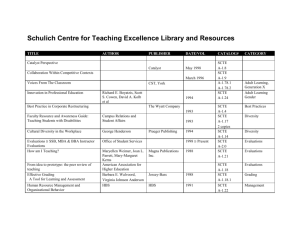Introduction
advertisement
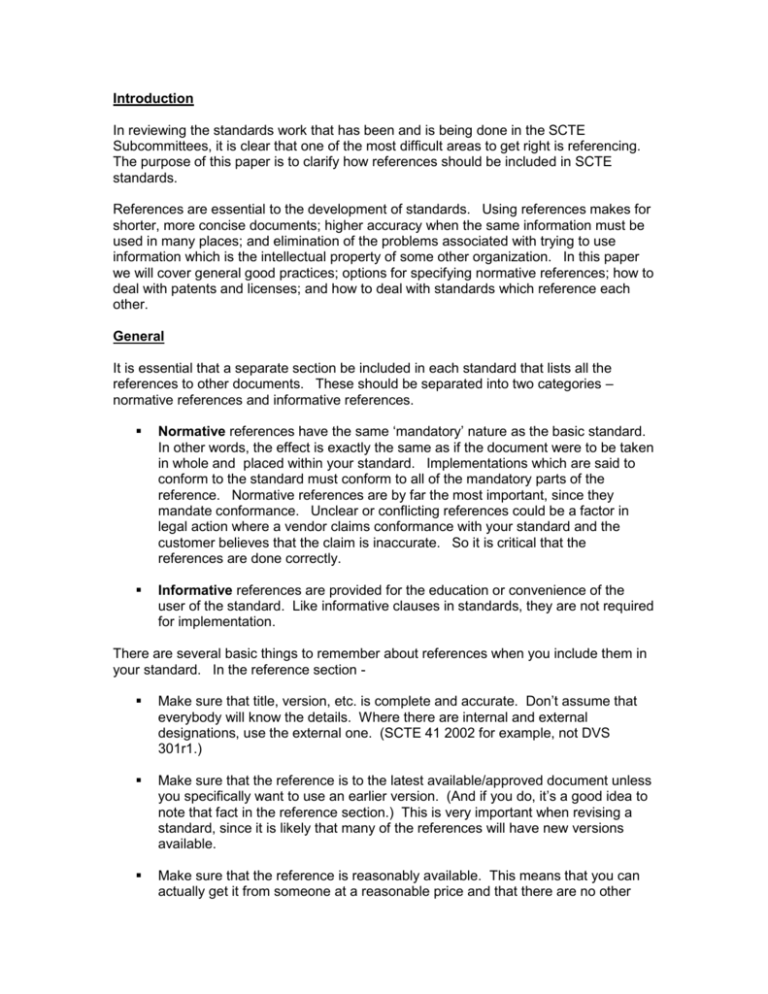
Introduction In reviewing the standards work that has been and is being done in the SCTE Subcommittees, it is clear that one of the most difficult areas to get right is referencing. The purpose of this paper is to clarify how references should be included in SCTE standards. References are essential to the development of standards. Using references makes for shorter, more concise documents; higher accuracy when the same information must be used in many places; and elimination of the problems associated with trying to use information which is the intellectual property of some other organization. In this paper we will cover general good practices; options for specifying normative references; how to deal with patents and licenses; and how to deal with standards which reference each other. General It is essential that a separate section be included in each standard that lists all the references to other documents. These should be separated into two categories – normative references and informative references. Normative references have the same ‘mandatory’ nature as the basic standard. In other words, the effect is exactly the same as if the document were to be taken in whole and placed within your standard. Implementations which are said to conform to the standard must conform to all of the mandatory parts of the reference. Normative references are by far the most important, since they mandate conformance. Unclear or conflicting references could be a factor in legal action where a vendor claims conformance with your standard and the customer believes that the claim is inaccurate. So it is critical that the references are done correctly. Informative references are provided for the education or convenience of the user of the standard. Like informative clauses in standards, they are not required for implementation. There are several basic things to remember about references when you include them in your standard. In the reference section Make sure that title, version, etc. is complete and accurate. Don’t assume that everybody will know the details. Where there are internal and external designations, use the external one. (SCTE 41 2002 for example, not DVS 301r1.) Make sure that the reference is to the latest available/approved document unless you specifically want to use an earlier version. (And if you do, it’s a good idea to note that fact in the reference section.) This is very important when revising a standard, since it is likely that many of the references will have new versions available. Make sure that the reference is reasonably available. This means that you can actually get it from someone at a reasonable price and that there are no other onerous terms and conditions associated with simply reading it. Provide sufficient information for the reader to obtain the document. Check the normative references in any normative reference! In the absence of any statement to the contrary, the entire reference chain becomes normative in your standard. In the body of the document Make sure that the reference is used at least once. There have been a number of instances where a document was listed as a normative reference, and then was never referenced in the body of the text. When this happens, it is likely that the reference should never have been normative. Make sure that the reference is specific as to which part of a normative reference is being used. Failure to do makes the entire document normative, and this may result in the inclusion of features that you did not intend to incorporate. Reference version control All references must be exact as to the reference that is being used. There are two ways of doing this: a reference to a specific incarnation of a document, or a reference to the most recent version. The issue that the developer must deal with is that the document referenced will change over time as its developer maintains and enhances it. This independent work may take the document in directions that were not foreseen when the reference was used. For this reason, the preferred way is to make the reference to a specific version – this will be identified with a date, a version number, an edition, or similar control information. (Some items, such as Internet Engineering Task Force (IETF) RFCs do not need supplementary information because their replacements have different numbers). When this kind of specific reference is included the standards writer knows that it will always have the same content – and while it may become obsolete from the point of view of its owner, your standard will not be affected. Their are two drawbacks to this approach. First, improvements in the referenced document which create a new version may be desirable in your standard, but you will have to revise (and reballot) yours to take advantage of the new document. And second, continued reliance on ‘old’ versions may lead to the point where the referenced document is no longer available. The other approach to a reference is to simply state that the reference is to the latest available version of the document. Now the advantage is that you do not have to keep watching for new versions, and you do not have to revise your own standard to take advantage of newer versions. However your standard is subject to changes in the direction of the referenced document, and you may find that your standard has normative aspects that are undesirable or even conflicting due to changes in the referenced documents. It is up to the standards developer to select how each reference should be done based on the stability of the referenced document and the best information about how it might proceed in the future. Specific references are preferred because control over content is maintained; but there is no objection to using ‘latest’ references where the situation dictates. Patents and Licenses SCTE standards may, under certain conditions, have intellectual property embodied in them such that a product implementation which conforms to the standard may require a license or other legal arrangement with the IP holder. This is most often a patent. The existence of such patents should be identified, and patent declarations are required according to SCTE policy. However the patent itself may, if necessary, be included as a reference since the use of the patent as a document requires no arrangements. Under normal circumstances a simple reference to someone else’s document does not create an intellectual property considerations. However there are some instances where the owner of the document requires additional agreements (e.g. a license where the document recipient must agree to certain things, or a non-disclosure agreement) in order to have access to the text. This is acceptable so long as the conditions for obtaining the document are, like patents, fair and non-discriminatory. As with patents, SCTE is not responsible for determining whether the conditions are met; this is a matter between the parties. Standards that reference developing standards It is sometimes necessary for developing standards to have references to other standards still in development. There are three cases. The simplest case is a unilateral reference; where your standard needs to reference another SCTE standard that is under development and which may not be finally approved until after yours gets final approval. This approach is discouraged since it gives a de facto approval outside of the regular process. However if it is necessary, it may be included. When this happens, the referenced draft will be provided on the web site through the Reference Resource spreadsheet available on the Standards Available page. Standards writers are cautioned, however, that references to drafts may introduce problems in conformance determination that could result in legal action between parties. Users of draft standards as references are asked to revise their own standards as soon as the official version is approved to avoid the simultaneous availability of various versions of SCTE standards. There are also several bilateral reference possibilities. One of the most common is where there is a product standard and an associated test procedure, and the author of the test procedure wishes to reference the product standard in order to tell the reader where the test will be used. This kind of bilateral reference is generally not acceptable. The product standard will define the tests that have to be performed, and these might include references to specific test standards. However the test procedure standard must be independent of the product specification (and still useful when product specifications change) and should therefore have no normative references back to the product. In cases like these, it is suggested that a general reference be made to “standards for products” so that interested parties can get additional information. The most difficult case is where two standards are interdependent; where they each require the other to be completed in order for the references to be correct, although the development process is being carried on in two groups. This could happen, for example, where both standards are being revised and content from one is moving into the other. In this case, the use of drafts is not acceptable. Under this circumstance, the two standards should be balloted at exactly the same time, with the understanding that a negative vote on one of them for technical reasons is to be treated as a negative vote on the other for a faulty normative reference. The two groups will then have to coordinate any revisions and withdrawal of negatives.

